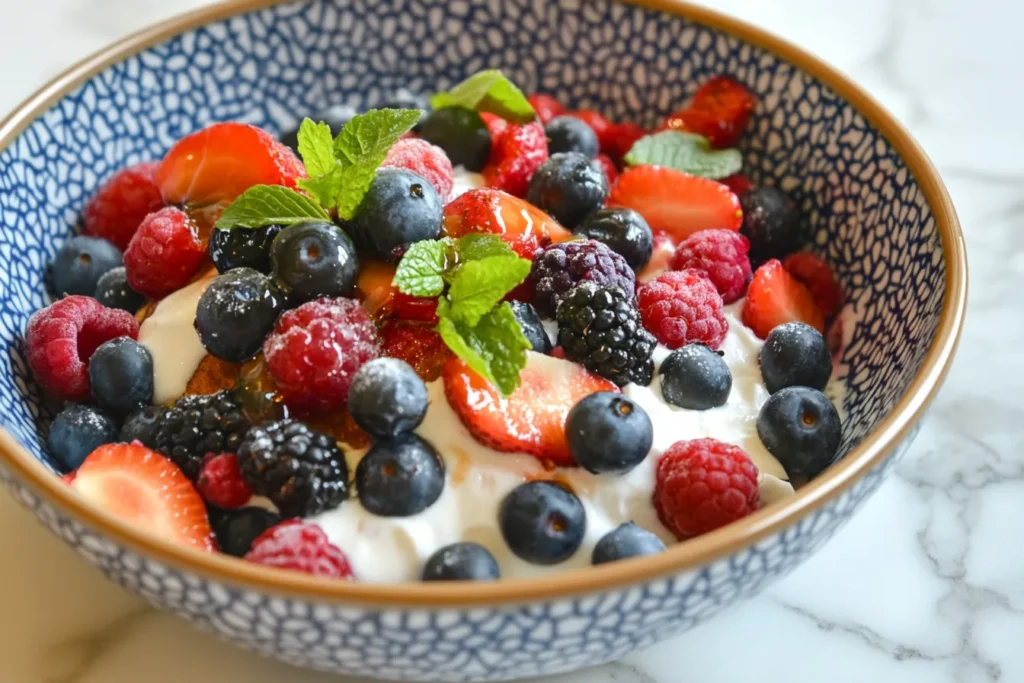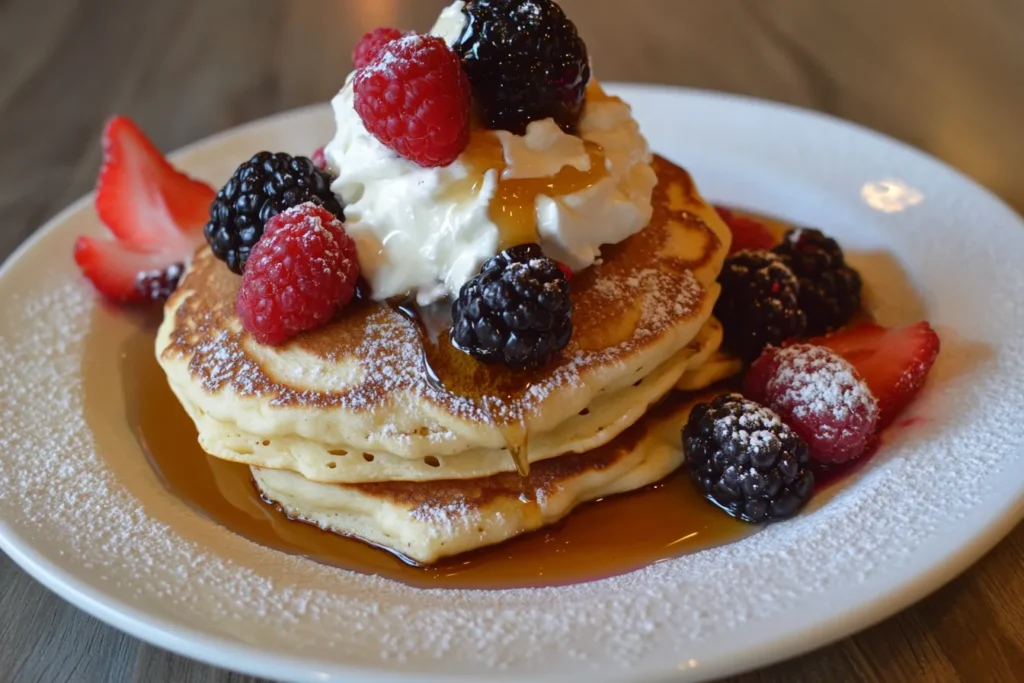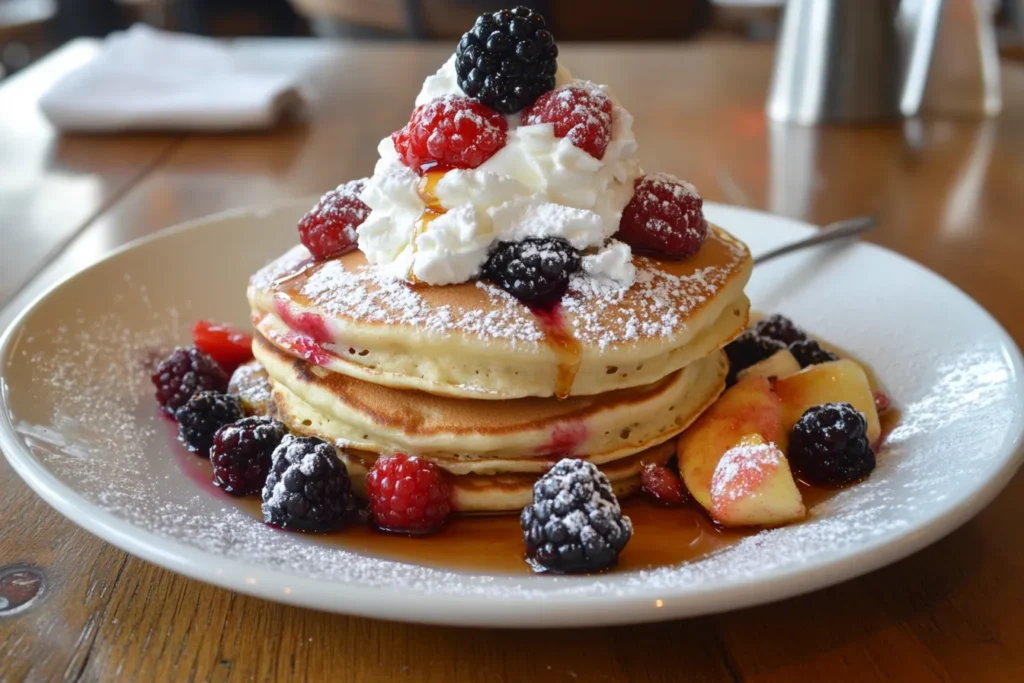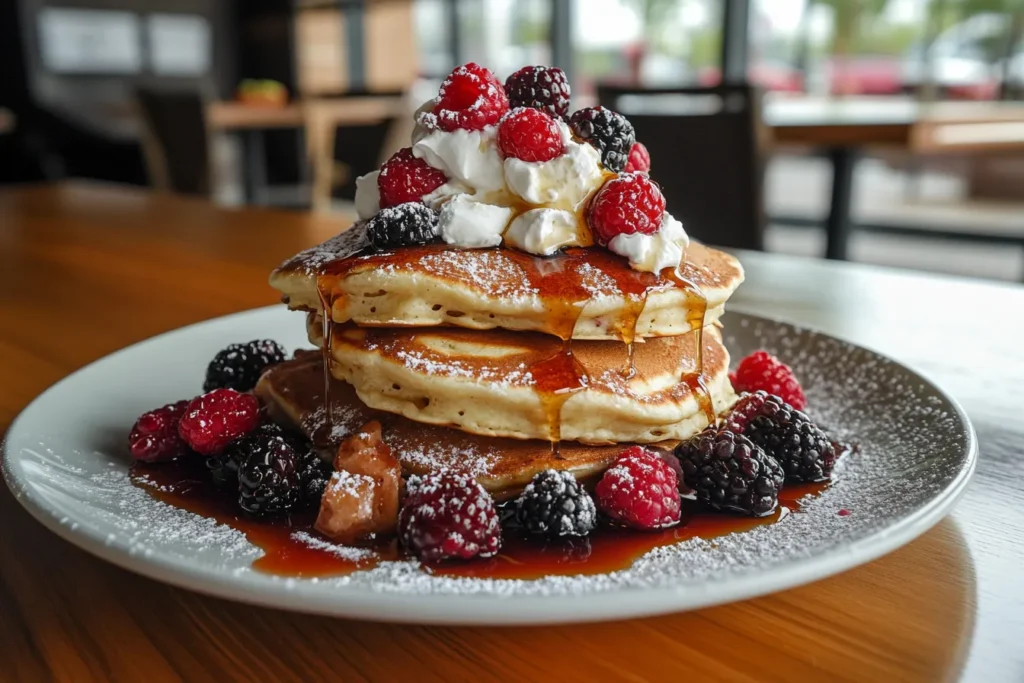Table of Contents
What makes pancakes taste better? That’s a question many home cooks ponder as they strive for breakfast perfection. Pancakes, a breakfast staple across cultures, are deceptively simple. However, achieving truly delectable pancakes requires a deeper understanding of ingredients, techniques, and flavor enhancements.
The Science Behind Delicious Pancakes
The Role of Ingredients
The basic pancake recipe consists of flour, leavening agent, salt, sugar, liquid, and fat. Each ingredient plays a vital role in the final product. Flour provides structure, baking powder or baking soda creates airiness, salt enhances flavor, sugar adds sweetness and promotes browning, liquid hydrates the dry ingredients, and fat contributes to tenderness and richness. Using high-quality ingredients will significantly impact the taste (What makes pancakes taste better?).
Mixing Matters
Overmixing pancake batter is a common pitfall. Developing too much gluten in the flour results in tough, chewy pancakes. Gently combine the wet and dry ingredients until just moistened. A few lumps are perfectly acceptable and even desirable. This ensures light and fluffy pancakes.
The Heat is On
The temperature of your griddle or pan is crucial. If it’s too hot, the pancakes will burn on the outside before they cook through. If it’s too cool, they will be pale and dense. Aim for a medium heat, around 350-375°F (175-190°C). A preheated griddle ensures even cooking and a beautiful golden-brown color (What makes pancakes taste better?).

12 Secrets to Amazing Pancakes
1. Brown Butter Brilliance
Browning butter unlocks a nutty, complex flavor that elevates any baked good, including pancakes. Simply melt butter in a saucepan over medium heat, continuing to cook until the milk solids turn golden brown and emit a fragrant aroma. Use this browned butter in place of regular melted butter in your recipe (What makes pancakes taste better?).
2. Buttermilk’s Tangy Touch
Replace regular milk with buttermilk for a tangy, moist, and tender pancake. Buttermilk’s acidity reacts with baking soda, creating extra lift and a delicate crumb.
3. The Secret Ingredient: Ricotta Cheese
Adding ricotta cheese to your pancake batter results in incredibly moist and tender pancakes with a subtle richness. The cheese also adds a delightful creaminess that elevates the overall texture.
4. Vanilla Extract’s Sweet Symphony
A teaspoon or two of vanilla extract can enhance the flavor of your pancakes, adding depth and complexity. Pure vanilla extract is always preferred over imitation vanilla for its superior flavor.
5. A Pinch of Spice for Intrigue
Experiment with adding a pinch of cinnamon, nutmeg, or cardamom to your pancake batter. These warm spices complement the other flavors and add a touch of sophistication.
6. Citrus Zest’s Zesty Zing
A little lemon, orange, or lime zest can brighten up your pancake batter and add a refreshing citrus note. The zest also releases aromatic oils that enhance the overall sensory experience.
7. Fresh Fruit’s Fruity Fun
Fold in fresh berries, sliced bananas, or diced apples into your pancake batter for a burst of flavor and texture. Choose seasonal fruits for the best taste and nutritional value.
8. Chocolate Chips’ Decadent Delight
Chocolate chips are a classic pancake addition, adding sweetness and a melty, gooey texture. Use high-quality chocolate chips for the best flavor (What makes pancakes taste better?).
9. Nutty Nibbles for Crunch
Add chopped nuts, such as pecans, walnuts, or almonds, to your pancake batter for a satisfying crunch and nutty flavor. Toasting the nuts beforehand enhances their flavor and aroma.
10. Coffee’s Bold Boost
Coffee adds a deep, rich flavor to pancakes, making them perfect for coffee lovers. Substitute some of the liquid in your recipe with strong brewed coffee or espresso.
11. Let the Batter Rest
Allowing the pancake batter to rest for 5-10 minutes before cooking allows the gluten to relax, resulting in more tender pancakes. This also gives the leavening agent time to work its magic, creating a lighter, fluffier texture (What makes pancakes taste better?).
12. Mastering the Flip
Patience is key when flipping pancakes. Wait until bubbles form on the surface and the edges are set before flipping. Use a thin, flexible spatula to gently flip the pancakes, avoiding excessive pressure (What makes pancakes taste better?).
What Makes Pancakes Taste Better? Focusing on the Details
What makes pancakes taste better often boils down to attention to detail. From using the right ingredients to mastering the cooking technique, every step contributes to the final result. Don’t be afraid to experiment with different flavors and textures to create your own signature pancake recipe. Explore other ideas, such as adding protein powder for a protein packed pancake, or using almond flour or coconut flour for a gluten-free pancake option (What makes pancakes taste better?).

Beyond the Basics: Pancake Variations
Savory Sensations
Pancakes don’t have to be sweet. Experiment with savory ingredients like cheese, herbs, and vegetables for a unique and satisfying meal. Add shredded cheddar cheese, chopped chives, or diced tomatoes to your pancake batter for a savory twist.
Stack ‘Em High: Topping Temptations
The right toppings can transform ordinary pancakes into an extraordinary breakfast experience. From classic maple syrup and butter to fresh fruit, whipped cream, and chocolate sauce, the possibilities are endless (What makes pancakes taste better?).
Pancake Artistry
Get creative and make pancake art! Use a squeeze bottle to create fun shapes and designs on the griddle. This is a great way to get kids involved in the cooking process and make breakfast more exciting (What makes pancakes taste better?).
The Future of Pancakes
Pancakes are a versatile and adaptable dish that can be enjoyed in countless ways. As culinary trends evolve, we can expect to see even more innovative and exciting pancake variations in the future. From vegan and gluten-free options to globally inspired flavors, the pancake possibilities are truly limitless (What makes pancakes taste better?).
Pancake Troubleshooting: Fixing Common Problems
Tough Pancakes: The Overmixing Culprit
Tough pancakes are often a result of overmixing the batter. Remember to gently combine the wet and dry ingredients until just moistened. A few lumps are perfectly fine. Overmixing develops gluten, which leads to a chewy texture (What makes pancakes taste better?).
Flat Pancakes: Leavening Issues
Flat pancakes may indicate an issue with your leavening agent. Ensure your baking powder or baking soda is fresh. To test its potency, add a small amount to hot water. If it fizzes, it’s still active.
Burnt Pancakes: Heat Control
Burnt pancakes are usually caused by cooking the pancakes at too high a temperature. Lower the heat to medium or medium-low and allow the pancakes to cook more evenly. Adjust cooking time accordingly (What makes pancakes taste better?).
Pancake Nutrition: A Balanced Breakfast
Choosing Healthy Ingredients
Opt for whole wheat flour instead of all-purpose flour for added fiber. Use healthier fats like coconut oil or olive oil instead of butter. Reduce the amount of sugar in your recipe or use natural sweeteners like honey or maple syrup (What makes pancakes taste better?).
Adding Protein and Fiber
Boost the nutritional value of your pancakes by adding protein powder, flax seeds, or chia seeds to the batter. These additions will keep you feeling fuller for longer and provide essential nutrients.
Portion Control
Pancakes can be high in carbohydrates and calories, so practice portion control. Enjoy a reasonable serving size and pair your pancakes with healthy toppings like fresh fruit, Greek yogurt, or a sprinkle of nuts (What makes pancakes taste better?).

Global Pancake Adventures: Recipes from Around the World
Dutch Baby Pancake: Oven-Baked Delight
The Dutch Baby pancake, also known as a German pancake, is a large, oven-baked pancake with puffed edges and a custardy center. It’s typically served with lemon juice, powdered sugar, and fresh fruit (What makes pancakes taste better?).
Crêpes: French Elegance
Crêpes are thin, delicate pancakes that can be filled with sweet or savory ingredients. Popular fillings include Nutella, fruit preserves, cheese, ham, and vegetables.
Banh Xeo: Vietnamese Crispy Pancake
Banh Xeo is a savory Vietnamese crepe made from rice flour, coconut milk, and turmeric. It’s typically filled with shrimp, pork, bean sprouts, and herbs, and served with a dipping sauce.
Mastering Pancake Presentation: Plating Perfection
The Classic Stack
A simple stack of pancakes topped with butter and maple syrup is a timeless presentation. Dust with powdered sugar for an extra touch of elegance.
Fruitful Arrangements
Arrange fresh fruit around the pancakes in a visually appealing way. Use a variety of colors and textures to create a stunning presentation (What makes pancakes taste better?).
Saucy Swirls
Drizzle sauces like chocolate sauce, caramel sauce, or fruit compote over the pancakes in an artistic swirl. Use a squeeze bottle for precise control.
The Psychology of Pancakes: Comfort Food and Nostalgia
A Childhood Favorite
Pancakes are often associated with childhood memories and feelings of comfort and warmth. The familiar aroma and taste can evoke powerful emotions and create a sense of nostalgia.
A Versatile Canvas
Pancakes are a blank canvas for culinary creativity. They can be customized to suit any taste or occasion, making them a versatile and comforting food for people of all ages.
Sharing and Connection
Making and sharing pancakes with loved ones is a great way to create meaningful connections and build lasting memories. The act of preparing and enjoying a meal together fosters a sense of community and belonging (What makes pancakes taste better?).
FAQ
What are three types of pancakes?
Three popular types of pancakes are American-style pancakes (thick and fluffy), crêpes (thin and delicate), and Japanese soufflé pancakes (incredibly light and airy).
coffee pancakes
Coffee pancakes are a delicious variation made by adding coffee to the batter. This imparts a rich, slightly bitter flavor that pairs well with sweet toppings like maple syrup and whipped cream.
Can I put coffee in pancake mix?
Yes, you can absolutely put coffee in pancake mix! Substitute some of the liquid called for in the recipe with strong brewed coffee or espresso. Start with a small amount and adjust to taste.
Why are restaurant pancakes so fluffy?
Restaurant pancakes are often fluffier due to a combination of factors, including using high-quality ingredients, properly aerating the batter, using a hot griddle, and not overmixing the batter. They also often use a higher ratio of leavening agent.

